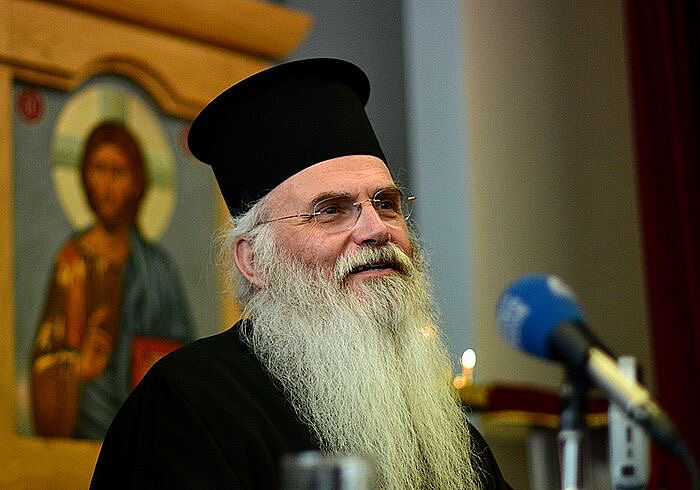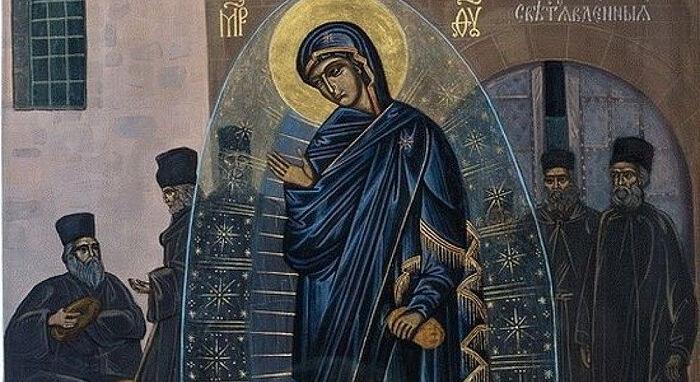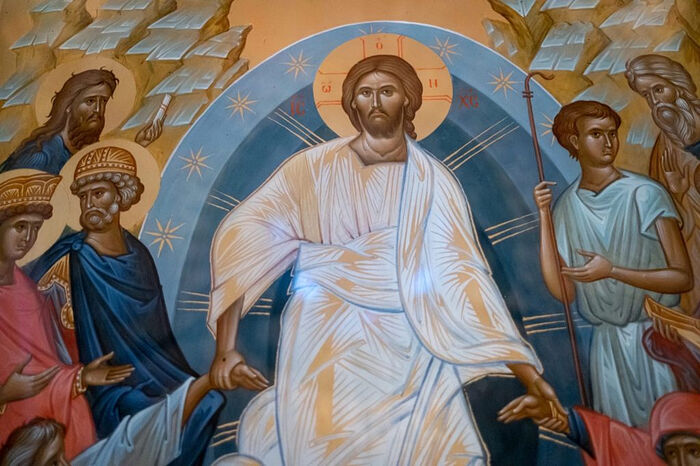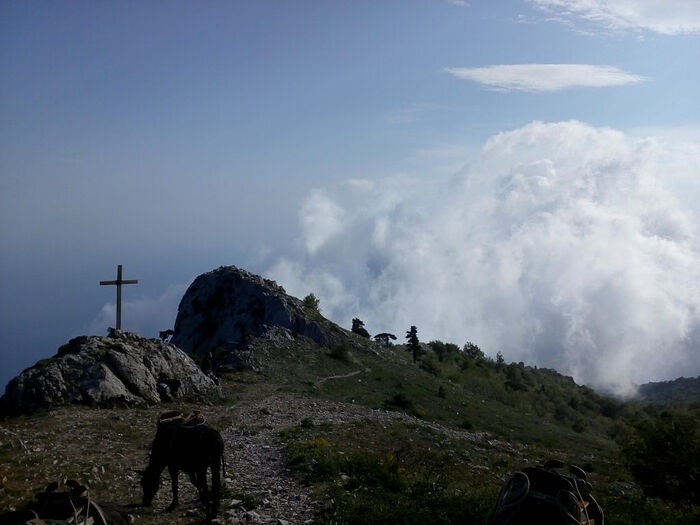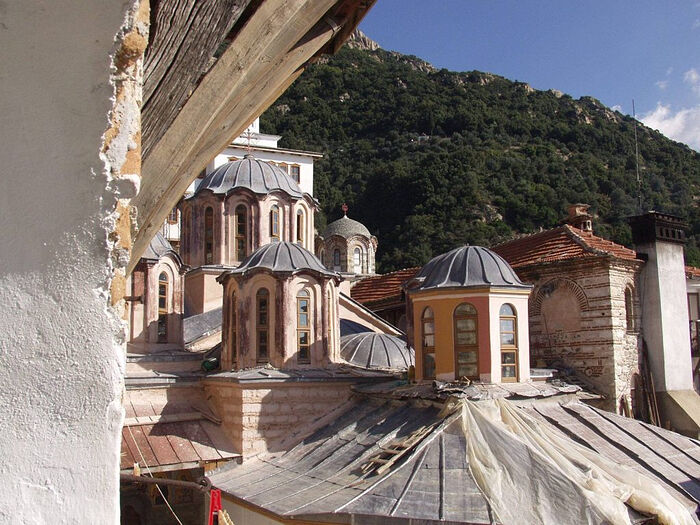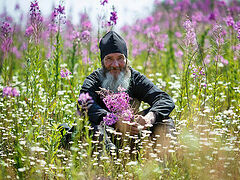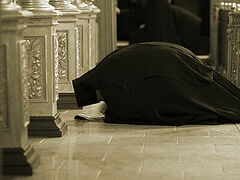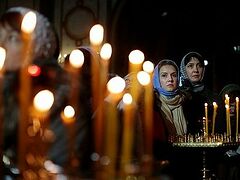“Begin from the Most Holy One”
Holy Mount Athos is known as the Garden of the Most Holy Theotokos, a unique place where the Person of the Most Holy Mother of God is honored, revealed, acts and rests. According to Tradition, Mt. Athos was chosen as the earthly domain for Her by the Lord Himself: “This place is Thy lot and garden and Paradise, a haven of salvation for those who seek it.”1
While the first Eve entered the original Paradise, the second Eve, the Mother of the second Adam, revealed the grace of Her name in the new Paradise—Mt. Athos. The Sovereign Mistress of the angels appears as the Sovereign Mistress of the angelic rank of monks. The Most Blessed One reveals grace flowing through Her icons, pilgrimage sites, sacred corners of Mt. Athos, life events awaiting answers to petitions, unexpected answers to outbursts of praise, the appearance of blessed ascetics, amid the compunction of cells or in the splendor of church. Everywhere and always, in every place and at every point, there is a unique occasion and opportunity for people to feel the embrace of the Most Holy Theotokos.
Perhaps there is no Athonite monk who does not percieve the Mother of God as his Most Holy One, Sovereign Mistress and first Refuge, unchanging Hope, Security and Protection, Intercessor and Mother, close and permanent Companion, Comforter of wounds and Receiver of his trials.
Every singer begins his lessons with the prayer “It is truly meet...” and demonstrates his skill with it. The first and best creations that every icon painter or wood carver makes are images of the Most Holy Theotokos. Every hesychast offers Her his most ardent prayer. Every monastery surrounds some of Her icons with the radiance of its reverence.
Historical events, everyday needs, living miracles, occurrences and circumstances—the features of the Theotokos are imprinted on every icon, which, by their artistic beauty and presence, console every monastery on Mt. Athos. Thus, in addition to the Icons of the Most Holy Theotokos “It Is Truly Meet” at the Protaton Church and the “Portaitissa” at Iveron Monastery, there are the Icon of the “Akathist Hymn” at Dionysiou Monastery, the “Myrrh-Streaming” Icon at Agiou Pavlou Monastery, the “Quick to Hear” Icon at Dochiarou Monastery, the Hodigitria (“Directress”) Icon at Xenophontos Monastery, the “Comfort” (“Consolation”) Icon at Vatopedi Monastery, the “Sweet Kissing” Icon at Philotheou Monastery, and many others.
Just as the holy Prophet Elias left his mantle to Elisha, the cincture of the Most Holy Theotokos is reverently preserved at Vatopedi Monastery as a precious inheritance, a blessing and a unique treasure.
“Rejoice, O Holy and Divine Mountain,” the hymnographer sings, poetically identifying the Most Holy Theotokos with Mt. Athos.2 The Mother of God does not abide on Mt. Athos—She Herself is the true Holy Mountain.
The presence of the Mother of God makes up for the absence of women in this place. That is why writings of unique value and theological and spiritual significance are the fruit of the great Athonite saints that speak of Her person. The famous homilies of St. Gregory Palamas on the Entry of the Theotokos into the temple, the canon of St. Nicodemus the Hagiorite, dedicated to the Icon “Quick to Hear”, the Theotokarion, and all its references to Her person we mentioned earlier, are filled with theological depth, sweetness of love and Divine feelings.
But even modern Holy Fathers, known and unknown, famous and obscure, pass through the Most Holy Theotokos and form their best world and the highest expressions of their faith. For Elder Joseph the Hesychast, “love for our Most Holy One is beyond any description. Whenever he remembered Her name, tears began to fall from his eyes. He prayed to Her for a long time to take him to ‘rest’. And the Queen of Heaven answered his prayers. She informed the elder a month before his death.” This happened on August 15, 1959, the feast of Her Dormition. The same reverent feelings were expressed by the ever-memorable Hieromonk Athanasios of Iveron Monastery in his letter to Monk Theoklitos of Dionysiou: “Begin with the Most Holy One... Concentrate on the thought that came to me while reading the Theotokarion. Even if heaven and earth were to disappear, the Akathist hymn and the Theotokarion would not disappear for a single day. And for whom are these hymns? For the Treasury of all the grace of God.”3
The Need for a “Sign”
The second remarkable element of Athonite spirituality is the need for experience and a “sign”. Mt. Athos is replete with miracles. Fragrant relics, legends and stories associated with icons, supernatural miracles, the charisma of holy monks, apparitions of saints, miraculous solutions to problems, corpses that retain their suppleness and do not emit the smell of decomposition and submission to the powers of nature, form a picture that develops in a natural way to describe, reveal and present God not as a strange and faraway miracle, but as a transcendent truth and reality easily confirmed by those who have eyes to see. So an innocent pilgrim on Mt. Athos is introduced to a spiritual life, strengthened by the fact that we believe, not because of thy saying: for we have heard Him ourselves, and know that this is indeed the Christ, the Saviour of the world (Jn. 4:42).
The spirituality of Holy Mount Athos is not based on intellectual theology, wise advice, human commandments, mechanical obedience and what usually leads to self-justification, but on the experience of God’s presence, which—unless it is a state of delusion—vivifies faith. Salvation is not an achievement or success, but grace and a gift from God.
This is why a believer who works out his salvation everywhere and always looks for signs of God’s presence. He proceeds from the experience of the “sign” and continues to “walk” with the conviction of its repetition and confirmation. He does not pursue, but waits for it. The goal is not to become good or decent people in order for a “sign” to happen, but to be given the “sign of the prophet Jonah” to discern it.4
Athonite life and experience is marked at every moment and in every aspect by a sign that is a common right, not a surprising exception. Nothing surprising—just the Existing God revealing Himself. The sign of the Prophet Jonah is given to every believer, who is called not to recognize the power of some abstract deity or the “power of the Divine”, but rather to see the face of God, Who knows how to answer petitions, overcome natural laws,5 surpass our desires,6 distribute to each human being according to his will,7 give signs in the lives of our brethren, and repeat His gifts in our lives.
In Orthodox life and tradition, what is called spirituality is the experience and manifestation of the Holy Spirit. But the Holy Spirit comes in the form of many tongues (cf. Acts 2:3). The spiritual life of Mt. Athos respects the diversity of Divine gifts, which are numerous and greatly varied.
Every corner of Mt. Athos speaks to you in its own way. Not only is a coenobitic monastery different from the desert, but every cell is different from the neighboring one, every slope is different from a nearby one, and every monk differs from his brother. Here you live God’s mystery, which does not correspond to any rules and is not an identity of opinion, an impressive similarity or an amazing coincidence, but manifests itself as a peaceful difference, an immeasurable and unexpected diversity, an inimitable uniqueness, a compatibility of opposites and a harmony of incompatible things. Everything is expressed naturally, with ease and simplicity. Mt. Athos is not afraid of diversity.
The spirituality of Mt. Athos does not try to convince you. You come to Mt. Athos and see everything for yourself. It does not seek to limit you in rules and directives. Neither does it tell you what you should do. A monk shows you how he lives and tells you about his life in God. He neither hurts you with the word “must”, nor says what you are expected to do, nor shows the goals you have to reach, nor exposes you with cruel words. You come to repentance through the many examples, and experience.
Interestingly, in his sermon on the day of Pentecost the holy Apostle Peter speaks of the Lord’s crucifiers, directly accusing them without denouncing them sternly.8 He refers to them as to people who did not understand what they had done. The words for they know not what they do (Lk. 23:34), said by the Lord, are also confirmed by the Apostle Peter’s words and spirit. You experience something similar every time you come into contact with Mt. Athos. They tell you the truth, but in such a way that you begin to repent without feeling selfish resistance in you. Mt. Athos does not call you to self-defense, but calls you to repentance.
It does not force you to imitate something good that already exists, but provokes you to “give birth” to your real gift, which is waiting to be manifested. Every monk is unique. What emphasizes the authenticity of truth is the variety of expressions and differences in character.
The consequence of all this is that Athonite spirituality is distinguished by its freedom and aesthetics. Here you do not choose God out of fear and insecurity. Moral rules exist, but not to set up barriers or protect. Above all, they exist to confirm love and indicate the direction. Ethics is not a precisely defined goal, but a natural fruit that ripens freely. On Mt. Athos you are not called to do what is necessary, but to choose what expresses God’s will. That is why shortcomings on Mt. Athos do not diminish its significance; neither do weaknesses in its monks surprise you. This all just humbles you.
But besides the freedom of choice and consent, there is freedom of risk and courage, freedom from conventions and compromise. Those who live in the absolute monastic extreme, those who always bear in the body the dying of the Lord Jesus (cf. 2 Cor. 4:10), have no reason to fall into the noose of compromise. They will be outside of it before it suffocates them. On Mt. Athos, freedom from the era and time reigns. Here, on the one hand, the past and traditions come into contact with the eschatological future. On the other hand, Mt. Athos frees you from the shackles of the present, from its forms and expressions. As long as every monk, every building, every creation, every custom, every impulse reminds you of the glory of Byzantium and a bygone age, they will guide you to eternal glory and the age to come.
Athonite spirituality also has its aesthetics. In the midst of its monotony, Mt. Athos was not afraid of art, but accepted, approved and manifested it. Behind every detail of creativity, behavior or spiritual expression, you see a disarming simplicity and amazing beauty, tenderness and nobility. In order for God to be true, “καλλει ωραιος παρα παντα ανθροπους”9 is absolutely necessary, and His tropos is in a still small voice.10
On Mt. Athos you feel awe at signs of the apostles (cf. Acts 2:43), find an opportunity for your repentance, experience the diversity of God’s grace, and feel God’s freedom and beauty. This is what Pentecost should be like.
The ascetic extreme and absolute
Holy Mount Athos is a concentration of ascetic and hesychast monasticism established on tradition and based on experience. To this day, Mt. Athos is a space where an absolute feeling of the greatest human measure and ascetic extremes reigns. The things you encounter here are closer to the Divine and transcendent than the human and natural.
Here man comes to know human nature in close proximity to God and in the greatest boldness towards Him. Here, on Mt. Athos, you see a life that is more reminiscent of the Kingdom of God, not a life governed by the visible world. Here the greatest reality is not a person, not the tempter who rules the world, not events that affect life, and not death which exists as a threat. Here events simply remind you of the transience and frailty of life; the devil exists in order to be defeated, and God lives and appears in order to be glorified.
“Everything is absolutely selfless, amazing, unearthly and very desirable for the glory of God, the most urgent and painful ‘extension’ of human beingness in order to reach and from here touch, if only with the tip of one’s finger, the Most Desired.”11 You can find this today in the blessed garden of the Most Holy Theotokos.
This extreme and absolute search for God is visible in all aspects of life on Mt. Athos. Indeed, even today the Athonite monastic rules are the strictest, as is the monks’ diet. Services are long—sometimes they last sixteen hours. Monks, filled with grace, freely lay their talents on the altar of obedience, conscious obscurity and everyday monotony, and renounce their nature to attain the supernatural.12
At Esphigmenou Monastery an icon of a crucified monk is located in a conspicuous place on the outer porch of the cathedral—not in order to encourage prudence, which is born from fear, but to show that the true glory of every monk and believer is a voluntary cross.13 This is what is mentioned in the Patericon: “Unless I destroy everything (old), I cannot raise myself up.”14 That is, the complete mortification of the old man, daily death,15 spiritual living in hell without losing the hope of salvation16 make up the atmosphere of spiritual life on Mt. Athos, which is free from death, the fear of it, and the burden of human nature.

